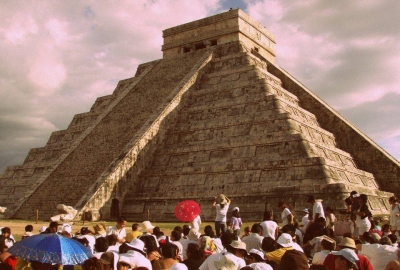
El Castillo—in Spanish, “the castle”—looms at the center of Chichén Itzá, a 79-foot pyramid of stone. Also known as the Pyramid of Kukulkán, the structure embodies Mayan myth along with natural astronomical cycles.
The phenomenon that El Castillo is famous for occurs twice each year, at the spring and fall equinoxes. (In fact, the effect is viewable for a week before and after each equinox.) As the equinox sun sets, a play of light and shadow creates the appearance of a snake that gradually undulates down the stairway of the pyramid. This diamond-backed snake is composed of seven or so triangular shadows, cast by the stepped terraces of the pyramid. The sinking sun seems to give life to the sinuous shadows, which make a decidedly snaky pattern on their way down the stairs.
Using the patterns of light and shadow appearing on El Castillo throughout the year, the Maya could easily have tracked the seasons and marked these four annual solar events—the two solstices and two equinoxes. And so it seems the ancient Maya may have used this structure as, among other things, a calendar to signal appropriate times to plant, harvest, and perform ceremonies.
Credit : Exploratorium
Picture Credit : Google




